Table of Contents
- Editor’s Choice
- Growth of the Cloud Computing Market
- Public Cloud Statistics
- Private Cloud Computing Statistics
- Hybrid Cloud Computing Statistics
- Security Cloud Computing Statistics
- Leading Service Providers – Cloud Computing Statistics
- Cloud Computing Statistics – Adoption in Healthcare
- Cloud Computing Statistics – Adoption in Finance
- Cloud Computing Statistics – Adoption in Retail
- Cloud Adoption in Manufacturing
- Cloud Computing Statistics – Big Data
- Cloud Computing Statistics – Artificial Intelligence
- Cloud Security and Compliance
- Future Trends in Cloud Computing
- Recent Developments
- Key Takeaways
- FAQs
Cloud Computing Statistics: Cloud computing is a technology that enables the delivery of computing resources, such as servers, storage, databases, networking, software, and analytics, over the internet.
Instead of owning and maintaining physical infrastructure, individuals and businesses can access and utilize these resources on demand from a cloud service provider.
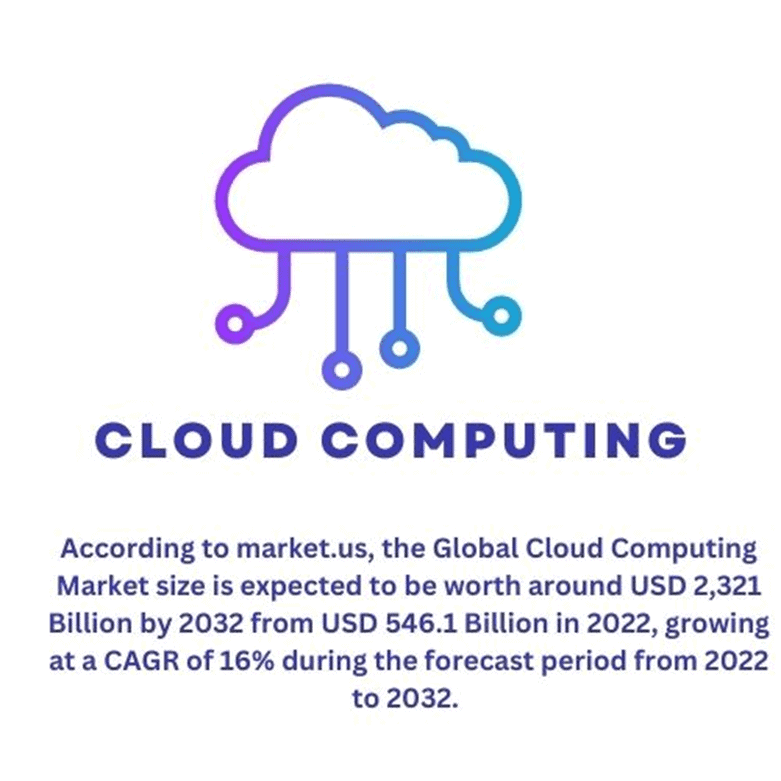
Editor’s Choice
- The Global Cloud Computing Market size is expected to be worth around USD 2,321 Billion by 2032 from USD 546.1 Billion in 2022, growing at a CAGR of 16% during the forecast period from 2022 to 2032.
- Worldwide public cloud end-user spending to reach nearly $600 billion in 2023.
- As of 2022, the top three public cloud service providers are Amazon Web Services (AWS) with a market share of approximately 31%, Microsoft Azure with 20%, and Google Cloud Platform (GCP) with 9%.
- According to a survey, 94% of enterprises use the cloud in some capacity, with 83% adopting a multi-cloud strategy.
- In 2022, the worldwide public cloud services market generated revenues of $312 billion, representing a 24.1% increase from the previous year.
- The most significant cloud computing security concern is data breaches, with 68% of organizations listing it as a top worry.
- By 2023, it is estimated that 67% of enterprise infrastructure will be cloud-based, up from 10% in 2015.
(Source: Synergy Research Group, Flexera, IDC, LogicMonitor’s Cloud Vision 2020: The Future of the Cloud Study, Deloitte)
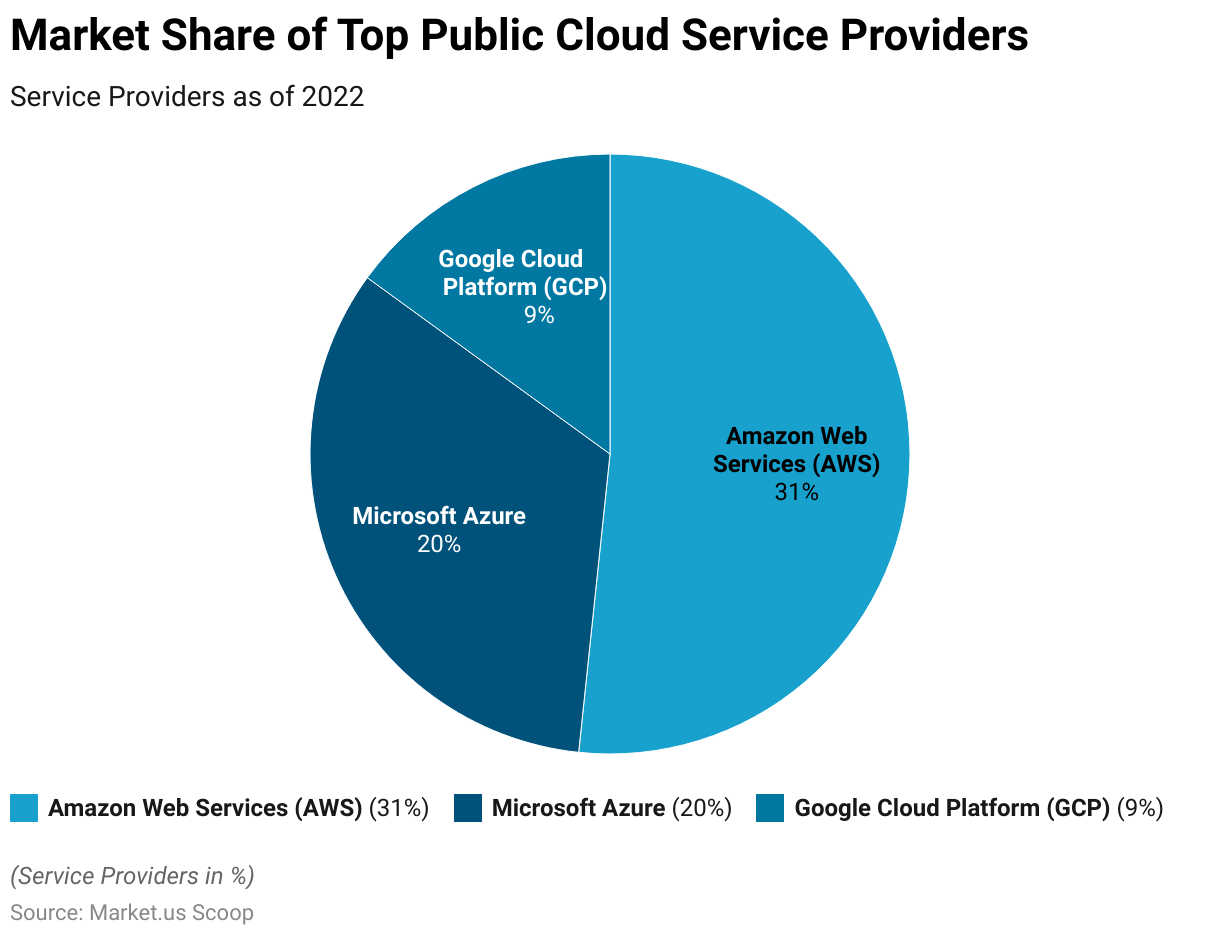
Growth of the Cloud Computing Market
- Worldwide spending on public cloud services is forecasted to reach $1.1 trillion in 2022, representing a 23.1% increase from the previous year.
- Global spending on Infrastructure as a Service (IaaS) is expected to reach $106 billion in 2022, up from $39.5 billion in 2019.
- 94% of enterprises are using the cloud in some capacity.
- 83% of enterprise workloads will be in the cloud by 2023.
- Amazon Web Services (AWS) is the leading public cloud service provider, holding around 32% of the global market share.
- Microsoft Azure is the second-largest public cloud provider, with a market share of around 20%.
- In Q1 2021, public cloud revenue exceeded $40 billion, representing a year-over-year growth of 35%.
- The public cloud services market is estimated to grow by 23.1% in 2022, reaching $397.4 billion.
(Source: Market.us, IDC, Flexera, LogicMonitor, Canalys)
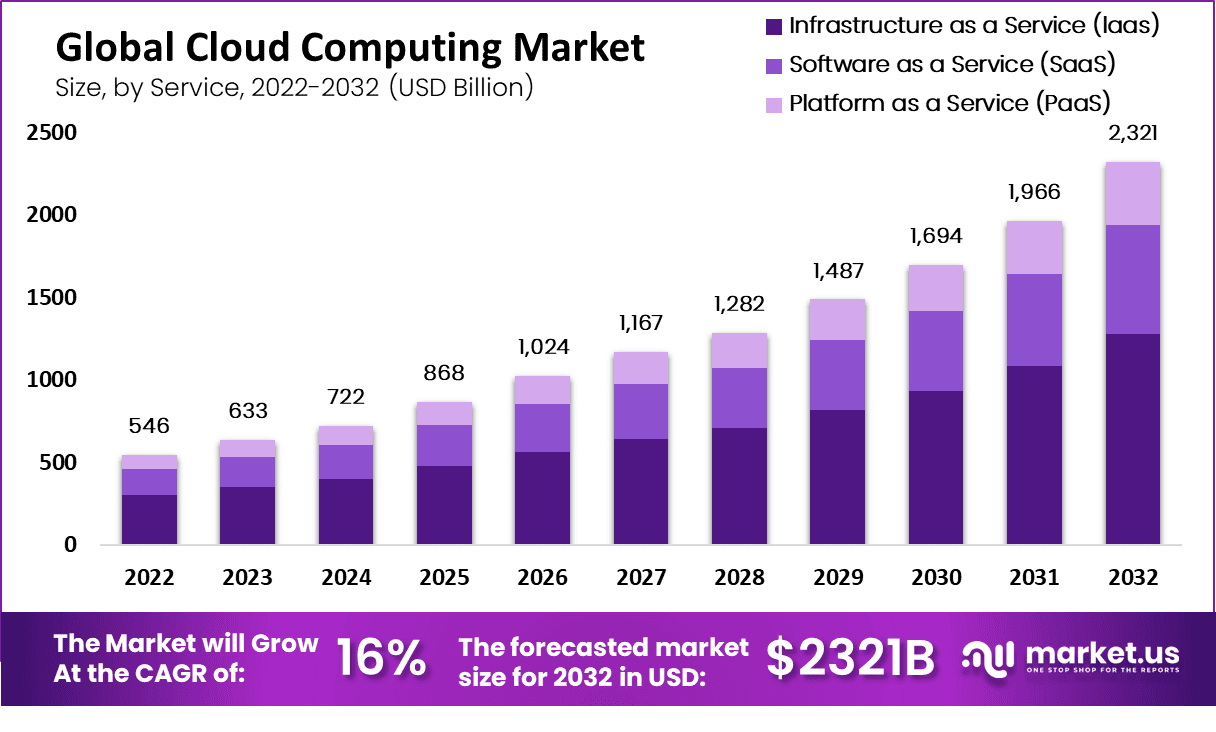
Public Cloud Statistics
- The global public cloud services market is projected to reach $623.3 billion in 2023, with a compound annual growth rate (CAGR) of 16.7% from 2018 to 2023.
- In 2020, the public cloud market size was estimated at $257.5 billion, representing a year-over-year growth of 6%.
- According to a survey by Flexera, 94% of organizations are using the public cloud in some form.
- The most common public cloud use cases include application hosting (66%), website hosting (62%), and storage and backup (62%).
- Organizations that migrate to the public cloud can achieve cost savings of 15% to 50% on average compared to traditional on-premises infrastructure.
- Containers and container orchestration platforms, such as Docker and Kubernetes, are widely used in the public cloud environment. In 2021, 83% of organizations reported using containers, and 77% used container orchestration.
(Source: IDC, Flexera 2021 State of the Cloud Report)
Private Cloud Computing Statistics
- According to a survey conducted by Flexera, 91% of enterprises have adopted a private cloud strategy in 2021.
- The global spending on private cloud infrastructure is projected to reach $40.6 billion in 2021, representing a 12.6% increase compared to the previous year.
- The top benefits cited by organizations for adopting private cloud include improved security and compliance (68%), increased performance and reliability (59%), and greater control over resources (52%).
- The major challenges faced by organizations in implementing private cloud include the complexity of implementation (45%), lack of internal skills and expertise (40%), and high upfront costs (37%).
- In terms of market share, some of the leading private cloud vendors include VMware, Microsoft, IBM, Dell Technologies, and Oracle.
- While public cloud adoption is increasing, private cloud continues to have a significant presence. According to a survey by IDG, 59% of organizations have a hybrid cloud strategy that combines both private and public clouds.
(Source: IDC, IDG)

Hybrid Cloud Computing Statistics
- Approximately 80% of enterprises have a hybrid cloud strategy in place.
- The global hybrid cloud market is projected to reach $128.01 billion by 2025, growing at a CAGR of 19.3% from 2020 to 2025.
- 94% of enterprises believe that adopting a hybrid cloud strategy improves their organization’s security posture.
- 77% of organizations state that the hybrid cloud enables them to deliver applications faster.
- The top challenges for implementing a hybrid cloud include security and compliance concerns (62%), lack of cloud expertise (47%), and difficulty integrating cloud and on-premises systems (47%).
- By 2023, it is estimated that 41% of enterprise workloads will be run in public clouds, 20% in private clouds, and 22% in hybrid clouds.
- The most common use cases for hybrid cloud include data backup and recovery (65%), big data processing and analytics (48%), and application development and testing (45%).
(Source: Forbes, Flexera, IBM, IDG, LogicMonitor, RightScale)
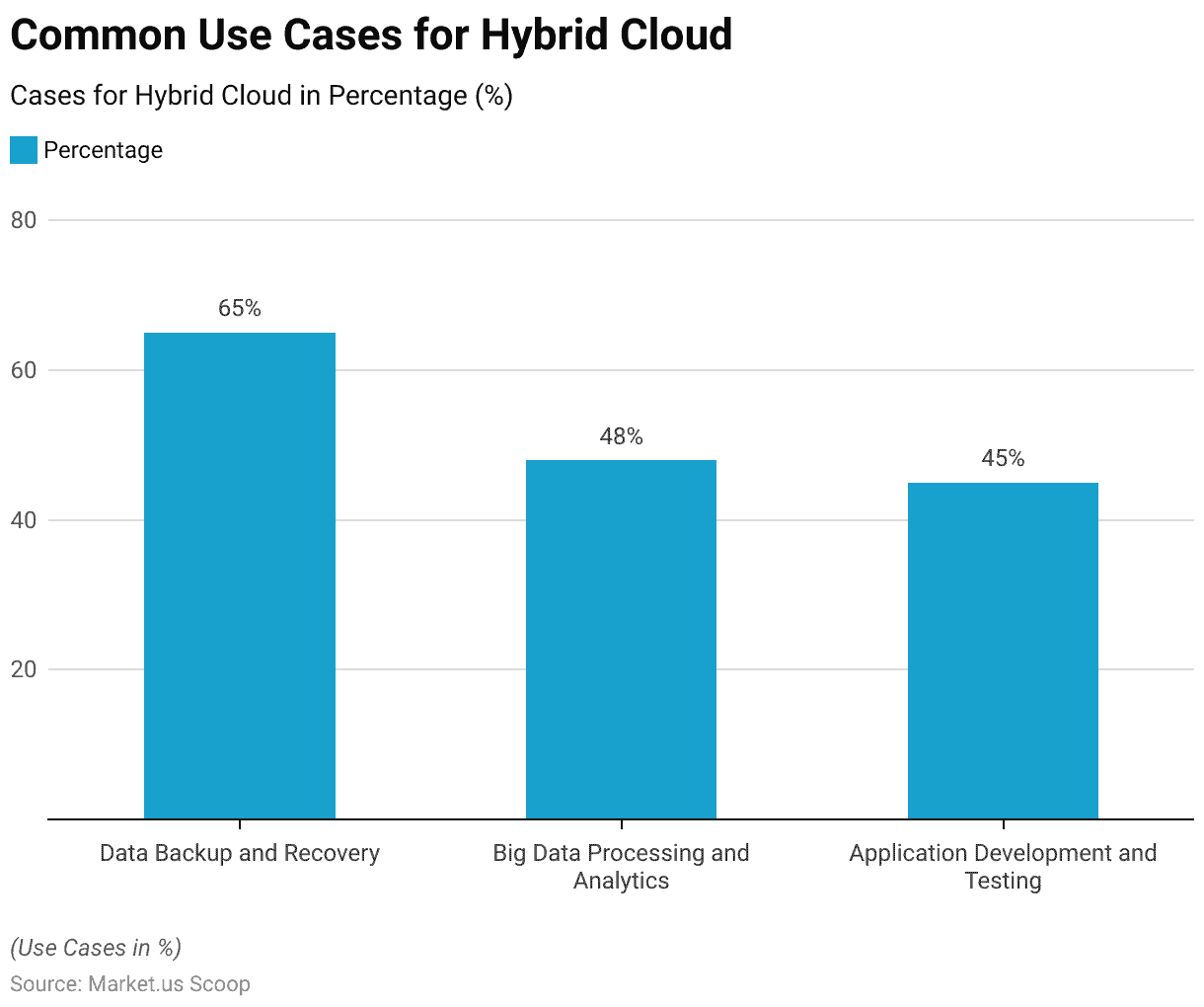
Security Cloud Computing Statistics
- 94% of enterprises are concerned about cloud security.
- In 2021, the average cost of a data breach was $4.24 million.
- Misconfiguration of cloud resources accounted for 19% of data breaches.
- 70% of organizations experienced a public cloud security incident caused by insider actions.
- Malicious insiders were responsible for 43% of cloud data breaches.
- Only 35% of organizations have a dedicated cloud security team to deal with compliance.
- 99% of cloud security failures will be the customer’s fault through 2023.
- Only 43% of organizations encrypt their sensitive data in the cloud.
- Encrypting data in the cloud reduces the average cost of a data breach by $360,000.
- MFA adoption has increased to 57% across organizations.
- Organizations that fully deploy security automation save an average of $3.58 million per breach.
- The global cloud security market is expected to reach $68.5 billion by 2026.
(Source: McAfee, IBM, Verizon, Deloitte, Microsoft)
Leading Service Providers – Cloud Computing Statistics
Amazon Web Services (AWS)
- AWS is the largest cloud service provider globally, offering a wide range of cloud computing services.
- AWS had revenue of $45.37 billion in 2020, representing a year-over-year growth of 29%.
- AWS holds a significant market share of around 32% in the global cloud services market.
(Source: Amazon)
Microsoft Azure
- Microsoft Azure is the second-largest cloud service provider, offering a comprehensive suite of cloud services.
- In Q4 2021, Microsoft reported a 50% revenue growth for Azure compared to the previous year.
- Azure has a substantial market share of approximately 20% in the global cloud services market.
(Source: Microsoft, Synergy Research Group)
Google Cloud Platform (GCP)
- Google Cloud Platform is another major player in the cloud services market, providing a variety of cloud-based solutions.
- In 2020, Google Cloud reported revenue of $13.06 billion, with a year-over-year growth rate of 46%.
- GCP holds a significant market share of around 9% in the global cloud services market.
(Source: Alphabet, Synergy Research Group)
Alibaba Cloud
- Alibaba Cloud is the leading cloud service provider in China and one of the largest globally.
- Alibaba Cloud’s revenue reached $2.81 billion in Q2 2021, representing a year-over-year growth of 29%.
- Alibaba Cloud has a strong presence in the Asian market and continues to expand its services globally.
(Source: Alibaba)
IBM Cloud
- IBM Cloud is a prominent cloud service provider, offering a range of infrastructure and platform services.
- In 2020, IBM reported cloud revenue of $25.1 billion, with a year-over-year growth rate of 20%.
- IBM Cloud has been focusing on hybrid cloud solutions and catering to enterprise customers.
(Source: IBM)
Cloud Computing Statistics – Adoption in Healthcare
- The global healthcare cloud computing market size is expected to be worth around USD 201.1 billion by 2032 from USD 41.4 billion in 2022, growing at a CAGR of 17.6% during the forecast period from 2023 to 2032.
- In a survey of healthcare organizations, 82% reported using cloud-based services, while 67% were using cloud-based applications.
- The adoption of cloud computing in healthcare is driven by cost savings, with organizations experiencing an average cost reduction of 12.1% after implementing cloud solutions.
- 48% of healthcare organizations are currently using the cloud for data storage, while 41% are using it for backup and disaster recovery purposes.
- The primary factors driving cloud adoption in healthcare include scalability and flexibility (61%), cost savings (58%), and data storage capacity (52%).
- Healthcare providers in the United States spent an estimated $3.73 billion on cloud computing services in 2020, and this expenditure is expected to increase to $10.24 billion by 2025.
- 80% of healthcare IT leaders believe that cloud computing is the most secure form of IT infrastructure for managing sensitive patient data.
- The use of cloud-based telemedicine platforms has grown significantly, with virtual consultations increasing by 100% during the COVID-19 pandemic.
- Cloud-based electronic health record (EHR) systems are becoming more prevalent, with 63% of healthcare organizations adopting or planning to adopt cloud-based EHR solutions.
(Source: Market.us, HIMSS Analytics, Healthcare Information and Management Systems Society, HIMSS Analytics, Statista, Frost & Sullivan, KLAS Research)
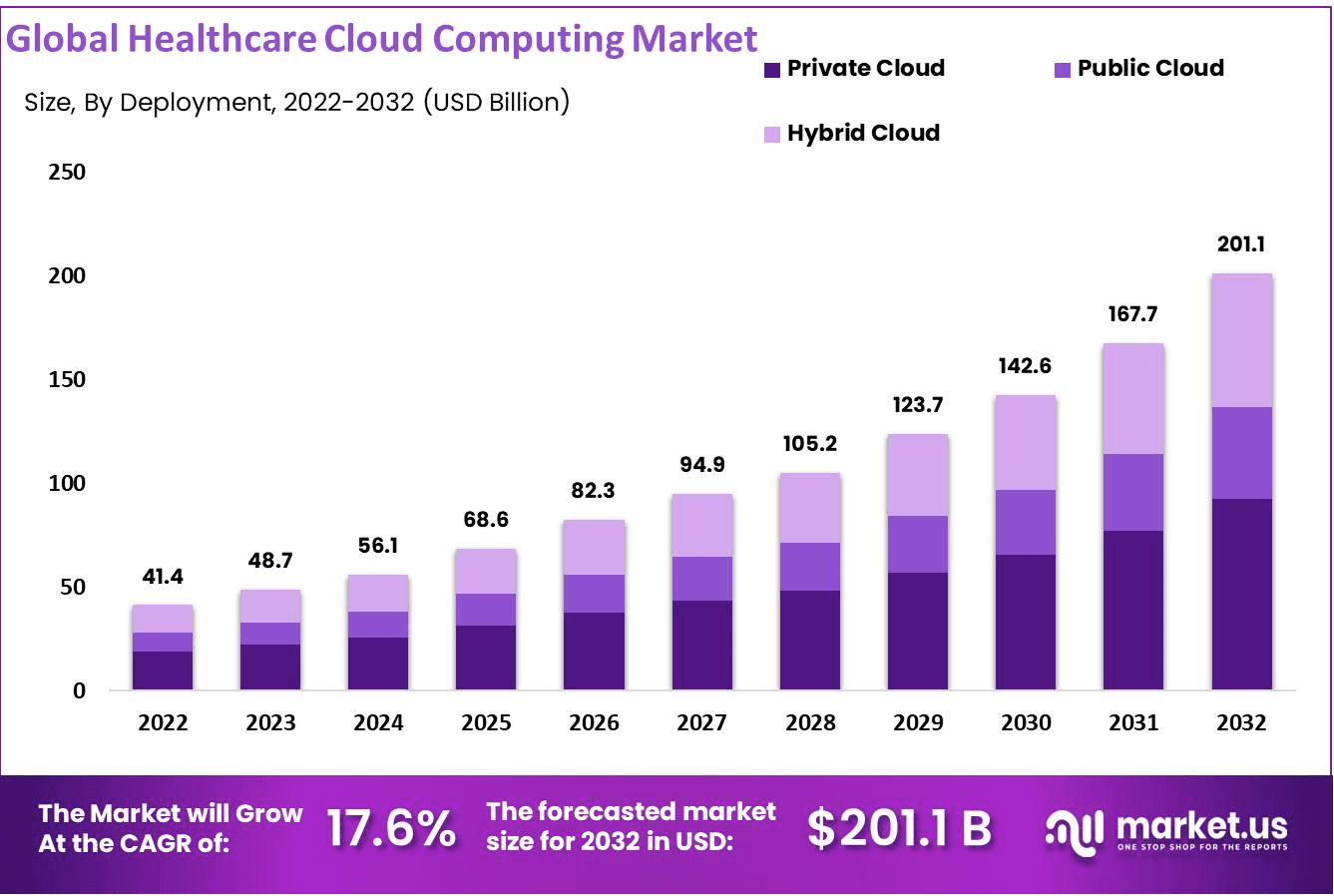
Cloud Computing Statistics – Adoption in Finance
- The adoption rate of cloud services in the finance industry is estimated to be around 70% by 2023.
- 80% of financial institutions cite security and compliance as the primary reasons for adopting cloud services.
- Financial institutions that migrate to the cloud can achieve cost savings of up to 30% on infrastructure costs.
- 82% of financial organizations have a hybrid cloud strategy, combining both private and public cloud environments.
- 64% of financial organizations have improved data security and privacy after migrating to the cloud.
- 63% of financial organizations use cloud-based big data analytics solutions for enhanced business insights.
- 89% of financial executives believe that cloud computing enhances business agility and responsiveness.
(Source: Deloitte, Accenture, Flexera, Forbes, Synergy Research Group, PwC)
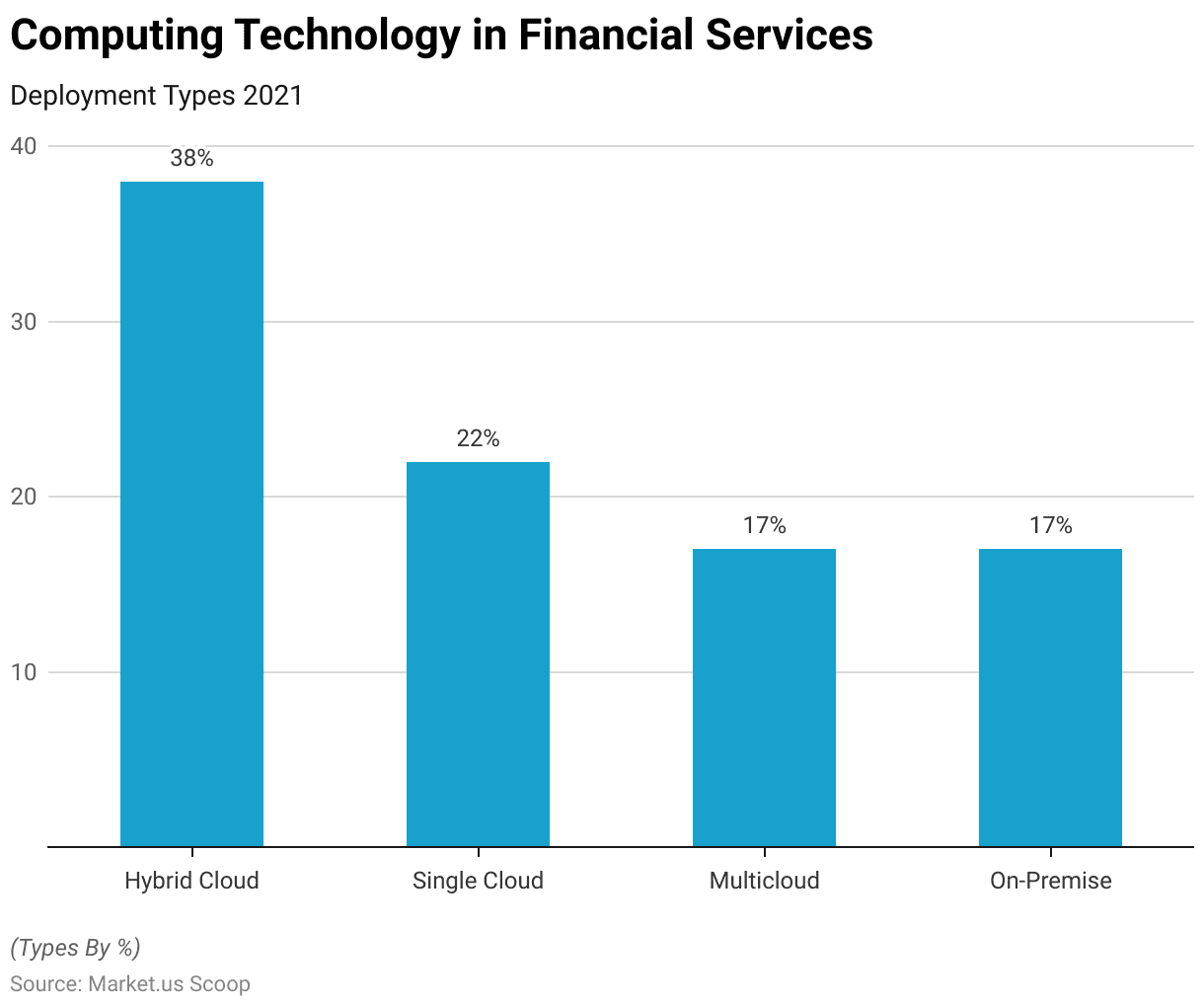
Cloud Computing Statistics – Adoption in Retail
- 80% of retailers are either using or planning to use the cloud for various operations.
- 83% of retailers experience improved IT agility and scalability through cloud adoption.
- 78% of retailers reported cost savings as a result of migrating to the cloud.
- 68% of retailers have implemented or plan to implement cloud-based POS systems.
- 75% of retailers are either using or planning to use cloud-based inventory management systems.
- 65% of retailers have migrated or plan to migrate their CRM systems to the cloud.
- 82% of retailers have deployed or plan to deploy e-commerce platforms in the cloud.
- 69% of retailers consider security as the biggest challenge when adopting cloud technology.
- 73% of retailers use cloud-based analytics to gain insights into customer behavior and improve decision-making.
- 58% of retailers have adopted a hybrid cloud approach, combining private and public clouds for their infrastructure.
(Source: RIS News, Forbes, RIS News, Deloitte, RIS News)
Cloud Adoption in Manufacturing
- The global cloud market in manufacturing is expected to reach $29.9 billion by 2025, growing at a CAGR of 21.7% from 2020 to 2025.
- 94% of manufacturing companies are using or considering using cloud-based ERP systems.
- 80% of manufacturing organizations have either already implemented cloud solutions or are planning to do so shortly.
- The use of cloud-based manufacturing applications is projected to increase by 47% in the next three years.
- 73% of manufacturers have reported improved agility and flexibility as a result of adopting cloud technologies.
- 64% of manufacturing companies have migrated at least one application to the cloud, with 45% using a public cloud provider.
- 58% of manufacturing executives believe that cloud computing will be a key driver of innovation in their industry.
- 55% of manufacturing companies have implemented or are considering implementing cloud-based analytics solutions to improve data analysis and decision-making.
- The main drivers for cloud adoption in manufacturing include cost reduction (75%), scalability and flexibility (64%), and access to advanced analytics (52%).
(Source: IDC Manufacturing Insights, Infor, IDC FutureScape, Salesforce, Statista, Deloitte, PwC, Oracle)
Cloud Computing Statistics – Big Data
- The global big data market is projected to reach $103 billion by 2027, growing at a CAGR of 10.9% from 2020 to 2027.
- Cloud-based big data deployments are expected to account for 35% of the overall big data market by 2023.
- Over 90% of organizations consider cloud computing to be a crucial part of their big data strategy.
- 53% of organizations are planning to increase their investment in cloud-based big data analytics.
- Cloud-based data warehouses, such as Amazon Redshift and Google BigQuery, have experienced a growth rate of over 100% in recent years.
- The adoption of cloud-based big data analytics platforms is driven by cost savings, scalability, and the ability to process large volumes of data efficiently.
- Approximately 85% of enterprises have a multi-cloud strategy for their big data initiatives.
- The healthcare industry is one of the leading sectors adopting cloud-based big data solutions, with an expected market size of $68.03 billion by 2025.
- Cloud-based big data platforms enable real-time analytics, with 82% of organizations leveraging real-time or near real-time data processing capabilities.
- The integration of artificial intelligence (AI) and machine learning (ML) with cloud-based big data platforms is a growing trend, with 53% of organizations adopting AI and ML for big data analytics.
(Source: IDC, IDG, Statista, Flexera, NewVantage Partners, Forbes)
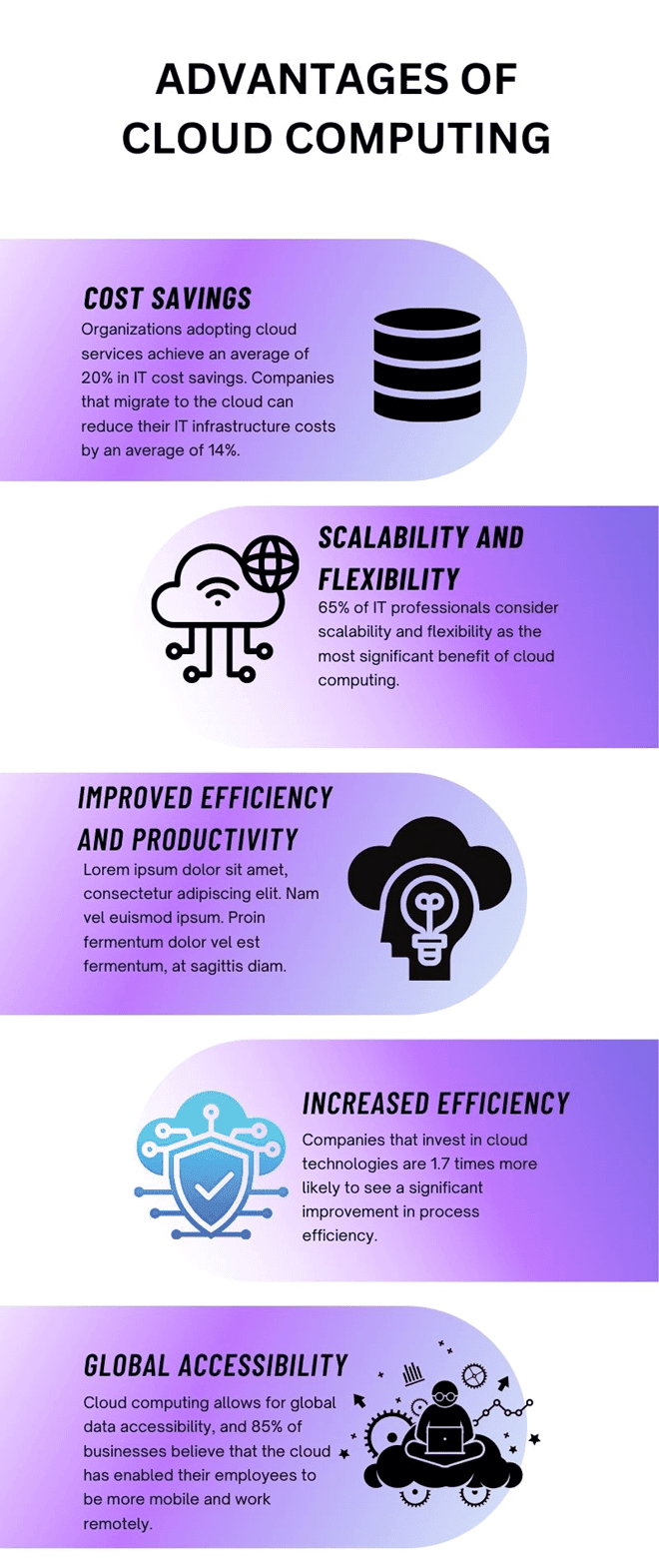
Cloud Computing Statistics – Artificial Intelligence
- By 2025, the global market for cloud-based AI services is projected to reach $97.9 billion, with a compound annual growth rate (CAGR) of 25.7% from 2020 to 2025.
- 83% of enterprise workloads will be in the cloud by 2023, with AI workloads being a significant driver of cloud adoption.
- Amazon Web Services (AWS) provides over 175 AI services, including machine learning, natural language processing, and computer vision.
- Microsoft Azure offers more than 100 AI services and APIs for various applications, such as speech recognition, image recognition, and Chatbot development.
- By 2023, 75% of commercial enterprise applications will use AI, with many leveraging cloud-based AI services.
- 84% of enterprises believe that AI will give them a competitive advantage, and 70% of them are already using or exploring AI in the cloud.
- Cloud-based AI infrastructure can provide up to 100 times faster processing compared to traditional on-premises solutions, enabling accelerated AI model training and deployment.
- Cloud-based GPUs (Graphics Processing Units) are increasingly used for AI workloads, with a 2.5 times increase in GPU usage for machine learning from 2019 to 2020.
(Source: LogicMonitor, Amazon Web Services, Microsoft Azure, Infosys, IBM, Flexera)
Cloud Security and Compliance
Security Concerns
- 94% of businesses experienced an improvement in security after moving to the cloud.
- 66% of IT professionals believe that security is the biggest concern when adopting cloud services.
- 60% of organizations cite data loss and leakage as their top cloud security concern.
(Source: McAfee, IDG, CSA)
Data Breaches and Incidents
- 94% of organizations experienced a cloud data breach in the past year.
- The average cost of a data breach in the cloud is $3.86 million.
- Misconfiguration of cloud services is the leading cause of cloud-based data breaches.
(Source: Sophos, IBM, Trend Micro)
Compliance in the Cloud
- 77% of organizations believe that cloud adoption has helped them meet compliance requirements.
- 54% of businesses see compliance as the primary driver for cloud adoption.
- The global cloud compliance market is projected to reach $6.12 billion by 2025.
(Source: LogicMonitor, McAfee)
Cloud Security Practices
- Only 29% of organizations have a formal cloud security strategy in place.
- 85% of organizations have experienced a cloud security incident due to a misconfiguration.
- 74% of IT professionals are concerned about unauthorized access to their organization’s sensitive data in the cloud.
(Source: McAfee, IDG)
Future Trends in Cloud Computing
- By 2025, it is estimated that 75% of enterprise-generated data will be created and processed at the edge, outside of traditional data centers or the cloud.
- The global edge computing market is projected to reach $28.07 billion by 2026, growing at a CAGR of 34.9% from 2021 to 2026.
- The serverless architecture market is expected to grow from $7.6 billion in 2020 to $21.1 billion by 2025, at a CAGR of 22.7%.
- Function as a Service (FaaS) adoption is predicted to increase by 50% in 2023, enabling organizations to focus on developing business logic rather than managing infrastructure.
- 93% of organizations have a multi-cloud strategy, utilizing an average of 4.8 different clouds.
- Hybrid cloud adoption is expected to grow at a compound annual growth rate (CAGR) of 17.3% from 2021 to reach $128.01 billion by 2025.
(Source: Flexera State of the Cloud Report 2021)
Recent Developments
Acquisition:
- Salesforce’s Acquisition of Slack: In 2020, Salesforce, a leading cloud-based software company. Acquired Slack, a popular collaboration platform, for $27.7 billion.
- The acquisition aims to strengthen Salesforce’s position in the cloud computing market by integrating Slack’s messaging and collaboration capabilities into its suite of cloud-based business applications.
New Product Launches:
- Amazon Web Services (AWS) Launches Amazon Connect: AWS, a subsidiary of Amazon, introduced Amazon Connect. A cloud-based contact center service that enables businesses to set up and manage customer contact centers in the cloud.
- Amazon Connect offers features such as intelligent call routing, real-time analytics, and integration with other AWS services. Providing organizations with a scalable and cost-effective solution for customer engagement.
Funding:
- Series E Funding Round for Cloud Data Warehousing Startup Snowflake: Snowflake, a cloud data warehousing company, raised $479 million in its Series E funding round led by Dragoneer Investment Group and Salesforce Ventures.
- The funding will support Snowflake’s expansion efforts and further development of its cloud data platform, which allows organizations to store, manage, and analyze large volumes of data in the cloud.
Innovation in Cloud Technologies:
- Rise of Serverless Computing: Cloud providers are investing in serverless computing technologies, such as AWS Lambda and Google Cloud Functions, which allow developers to run code without provisioning or managing servers.
- Serverless computing enables organizations to build and deploy applications more efficiently, as they only pay for the computing resources used during code execution, rather than for idle server capacity.
Strategic Partnerships:
- Microsoft and AT&T Forge Cloud Computing Partnership: Microsoft and AT&T announced a strategic partnership to deliver cloud computing services to businesses using AT&T’s 5G network infrastructure.
- The partnership aims to enable enterprises to leverage the power of cloud computing and edge computing technologies for innovative applications such as the Internet of Things (IoT), artificial intelligence (AI), and augmented reality (AR).
Key Takeaways
Cloud Computing Statistics – Cloud computing has revolutionized the way businesses and individuals store, access, and utilize data and applications. Its scalability, flexibility, and cost-effectiveness make it a preferred choice for organizations of all sizes.
With cloud computing, users can leverage powerful computing resources, collaborate seamlessly, and benefit from enhanced security and disaster recovery capabilities.
As technology continues to evolve, cloud computing is expected to play an even more significant role in shaping the future of technology and driving innovation across industries.
FAQs
Cloud computing is a technology that enables the delivery of computing resources, such as servers, storage, databases, networking, software, and analytics, over the internet. Instead of owning and maintaining physical infrastructure, individuals and businesses can access and utilize these resources on demand from a cloud service provider.
Some leading industries include technology, finance, healthcare, e-commerce, and media. However, it’s worth noting that the adoption of cloud computing is expanding into virtually all sectors.
Cloud computing offers several advantages, including scalability, cost-efficiency, improved agility, accessibility from anywhere with an internet connection, enhanced data security, automatic software updates, and easier collaboration among teams.
Leading cloud service providers were Amazon Web Services (AWS), Microsoft Azure, and Google Cloud Platform (GCP). These providers offer a wide range of cloud services, including infrastructure as a service (IaaS), platform as a service (PaaS), and software as a service (SaaS).
Discuss your needs with our analyst
Please share your requirements with more details so our analyst can check if they can solve your problem(s)



